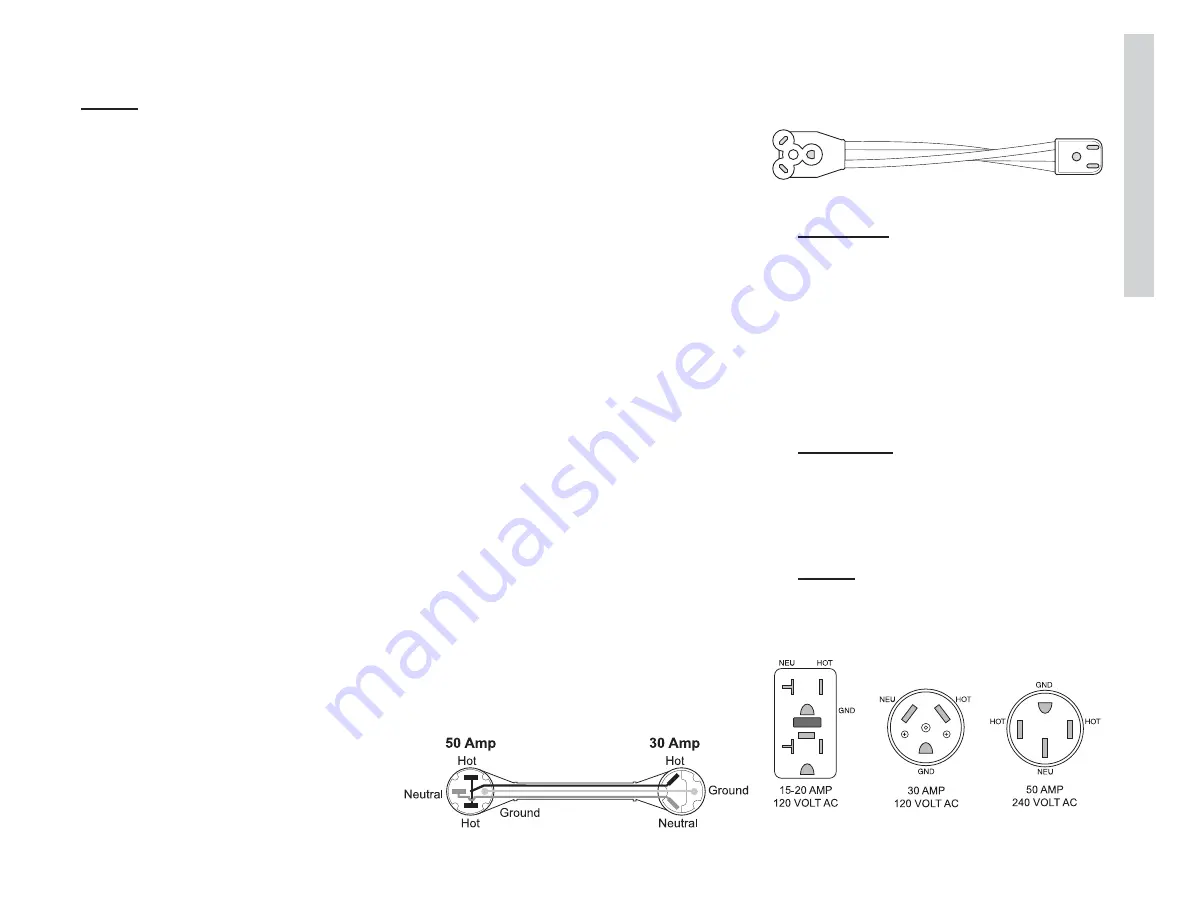
151
H
ou
se
E
lec
tri
ca
l -
8
2012 Trip
The LED on the power cord will
illuminate to verify power.
NOTE:
The LED does not illuminate when
connected to 30 Amp or 20 Amp
service. The microwave display will
illuminate to indicate shore power.
When Hooked to 50 Amps:
After verifying proper voltage, wait
approximately one minute for the inverter
to stabilize charging of the batteries before
starting air conditioners or other large AC
loads.
When Hooked to 30 Amps:
Allow the inverter sufficient time to stablize
battery charging before operating electric
appliances. Operate appliances and outlets in
sequence rather than all at the same time.
Disconnecting the Shore Cord:
Turn off all AC appliances.
Turn off the shore power breaker.
This will prevent accidental shock and
flashing of electrical contacts when
disconnecting.
Pivot plug handle to disconnect the
plug from the outlet.
Straighten, clean and store the cord.
Maintenance:
Routinely extend the cord full length and
straighten the cord on the ground to relieve
kinking.
Power Supply:
Amperage supplies vary greatly depending
on the amount of available current.
The continuous amount of current
through a breaker or fuse is 80% of its
rated capacity.
50 Amp 240 Volt AC shore power
service consists of two power
supply conductors, a neutral and a
safety ground. The 50 Amp breaker
simultaneously limits each power
supply conductor to no more than a
short-term maximum of 50 amps for
each conductor. 50 Amp 240 Volt
AC service actually provides 80
continuous amps.
Use care when hooked to anything
less than 50 Amp shore service.
Shore power service less than 50
Amps consists of one power supply
conductor, a neutral and a safety
ground; 30 Amp shore service is
limited to 24 continuous Amps; 20
Amp shore service is limited to 16
continuous Amps.
Electrical Adapters:
Different types of electrical adapters are
designed to suit a variety of different needs.
Only UL approved adapters should be used.
The most common adapter is a 50-30 Amp
adapter. This type of connector adapts the 50
Amp shore cord to a 30 Amp shore power
outlet. Always install the adapter to the cord
prior to making the connection to the outlet.
Another common adapter is a 30 to 20 Amp
adapter. This type of connector adapts the 30
Amp shore cord to a 20 Amp shore power
outlet.
CAUTION:
If shore power service is limited to 15
or 20 Amps, use of light duty extension
cords and electrical adapters will
create a voltage loss through the cord
and at each electrical connection.
Line voltage loss and the resistance
at each electrical connection can be a
hazardous combination. Damage to
sensitive electronic equipment may
result!
WARNING:
Avoid the risk of electrical shock or
component damage by disconnecting
from shore power during electrical
storm activity. Use the inverter or start
the generator if AC power is needed.
NOTE:
Three types of shore power outlets
most commonly used are shown in the
illustration.
060164
Typical 50 - 30 Amp Adapter
060121c
060174
Typical 30 - 20 Amp adapter:
Summary of Contents for Trip 2012
Page 1: ...2 0 1 2 B YHOL I D A YR A MB L E R O w n e r s Ma n u a l...
Page 13: ...Notes...
Page 45: ...40 Driv ing Safety 2 2012 Trip Weight Record Sheet...
Page 51: ...46 Driv ing Safety 2 2012 Trip Notes...
Page 138: ...133 W ater Sy stems 6 2012 Trip Water System Diagram 040487va...
Page 139: ...134 Wat er Sy stems 6 2012 Trip Notes...
Page 151: ...146 Pro p ane Sy tems 7 2012 Trip Notes...
Page 173: ...168 Ho us e Electr ical 8 2012 Trip Notes...
Page 190: ...185 Chassis Electrical 9 2012 Trip Engine No Start Flow Chart...
Page 191: ...186 Ch as s is Electr ical 9 2012 Trip Notes...
Page 237: ...232 Ch assis 10 2012 Trip Notes...





































